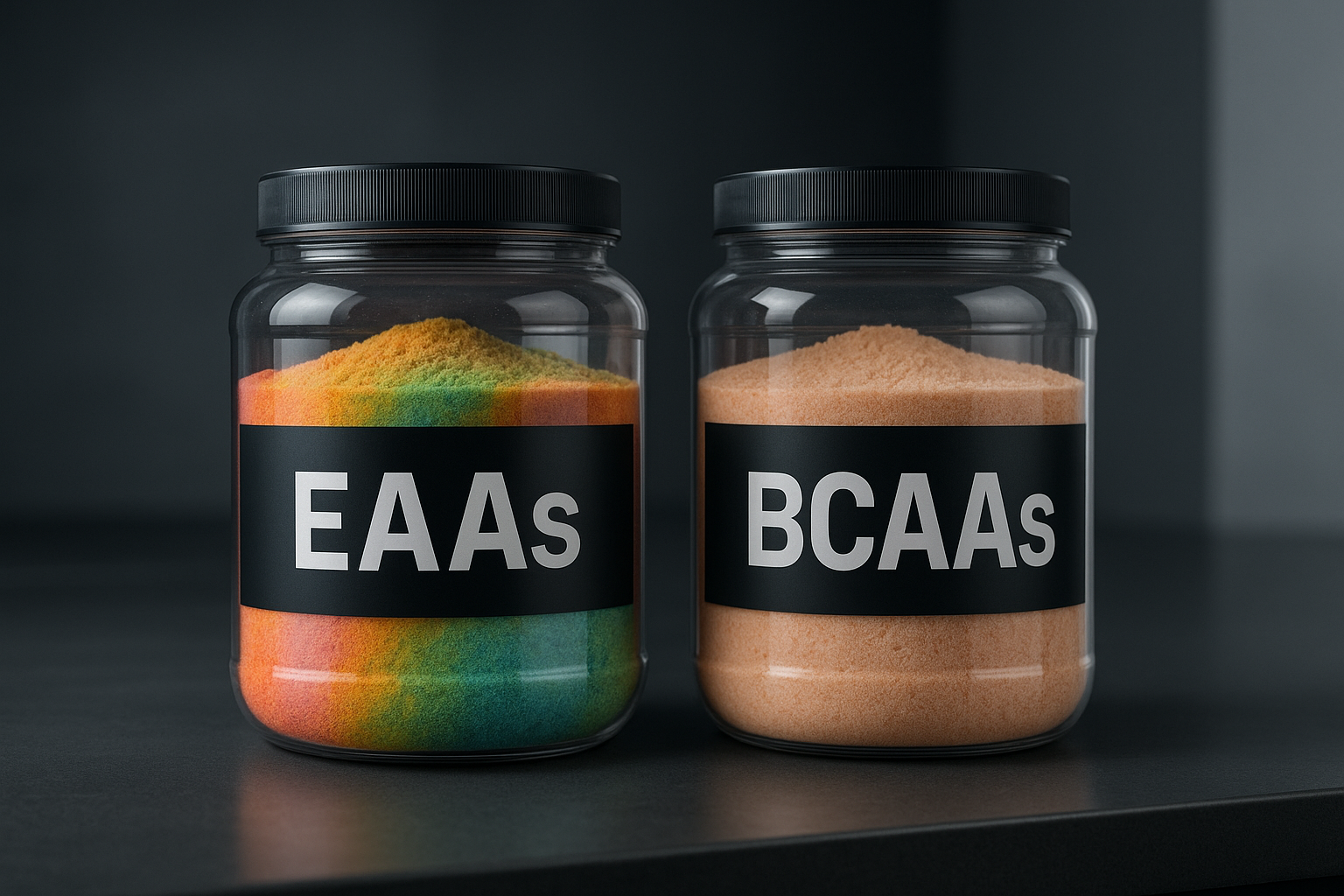
EAAs vs BCAAs: Understanding the Key Differences
EAAs (Essential Amino Acids) and BCAAs (Branched-Chain Amino Acids) are popular supplements in fitness and nutrition, but they serve different purposes. EAAs include all nine amino acids your body can’t produce, making them crucial for muscle building, repair, and overall health. BCAAs, on the other hand, are a subset of EAAs (leucine, isoleucine, valine) that help reduce muscle breakdown and fuel workouts.
Key Points:
- EAAs: All nine amino acids; needed for complete muscle protein synthesis and recovery.
- BCAAs: Three amino acids; provide workout energy and reduce muscle breakdown but can’t fully support muscle growth alone.
-
When to Use:
- EAAs: For muscle growth, recovery, and if your diet lacks protein.
- BCAAs: For workout energy and soreness reduction if you already meet protein needs.
Quick Comparison
| Feature | EAAs | BCAAs |
|---|---|---|
| Amino Acids | 9 (all required for protein synthesis) | 3 (leucine, isoleucine, valine) |
| Main Function | Builds and repairs muscle | Reduces muscle breakdown |
| Best For | Muscle growth and recovery | Workout energy and endurance |
| Diet Support | Fills protein gaps | Adds to an already sufficient diet |
EAAs are better for overall muscle health, while BCAAs are ideal for workout performance. Choose based on your training goals and dietary needs.
What Are EAAs (Essential Amino Acids)?
EAA Definition and Components
Essential amino acids (EAAs) are the nine amino acids your body can't produce on its own, meaning you need to get them from food or supplements. These amino acids include histidine, isoleucine, leucine, lysine, methionine, phenylalanine, threonine, tryptophan, and valine. They're crucial for building muscle, repairing tissues, and keeping your body functioning properly. Even a shortage of just one can throw off your body's ability to repair and maintain itself.
The World Health Organization provides specific daily requirements for these amino acids based on body weight. For example, adults need about 39 mg of leucine, 30 mg of lysine, 26 mg of valine, 4 mg of tryptophan, and around 10 mg each of histidine and methionine per kilogram of body weight. For someone weighing 150 lbs (about 68 kg), this would translate to approximately 2.7 grams of leucine and 0.3 grams of tryptophan daily. These amounts highlight just how essential EAAs are to your daily health.
How EAAs Help Your Body
EAAs play a key role in protein synthesis, which is how your body builds and repairs muscle tissue. They also support tissue repair and help with nutrient absorption, both of which are critical for maintaining healthy bodily systems. Without enough EAAs, you might experience problems with your immune system, digestion, nervous system, or even reproductive health.
You can find EAAs in whole foods that are rich in complete proteins. For instance, a 6‑oz serving of braised chicken breast provides about 55.9 grams of complete protein, which easily meets your daily EAA needs.
What Are BCAAs (Branched-Chain Amino Acids)?
BCAA Definition and Components
Branched-Chain Amino Acids (BCAAs) are a group of three essential amino acids: leucine, isoleucine, and valine. What sets them apart is their unique branched structure, which gives them their name.
These amino acids are highly concentrated in muscle tissue, where they play a crucial role. In fact, they make up 35% of the essential amino acids in muscle proteins and account for 40% of the preformed amino acids that mammals require [4]. This explains why BCAAs are so popular among athletes and fitness enthusiasts - they’re directly tied to muscle health and performance.
Since BCAAs are essential amino acids, your body can’t produce them on its own. You need to get them through your diet or supplements.
How BCAAs Help Your Body
BCAAs are particularly beneficial when it comes to exercise and maintaining muscle. Their main strengths lie in reducing muscle breakdown and providing energy during long or fasted workouts.
For example, research shows that consuming 5.6 grams of BCAAs after a workout can increase muscle protein synthesis by 22%. However, there’s an important caveat to how they work.
"BCAA ingestion stimulates muscle protein synthesis only when all essential amino acids are present to support translation and tissue formation." - Wolfe, Journal of the International Society of Sports Nutrition
This means that while BCAAs can kickstart the muscle-building process, they can’t sustain it alone. Think of it like trying to build a house with only three types of materials when you actually need nine to finish the job.
"Ingesting BCAAs without the full complement of EAAs results in a transient rise in MPS, followed by stagnation due to insufficient amino acid availability." - Wolfe, Journal of the International Society of Sports Nutrition
Among the three BCAAs, leucine stands out as the key player. It acts as the signal that tells your body to start building muscle. But even leucine can’t do the job alone - it needs support from all nine essential amino acids to keep the process going.
BCAAs are particularly effective for preserving muscle when taken around your workouts. This is especially true for fasted training or long, intense exercise sessions. Up next, we’ll compare BCAAs with EAAs to help you decide which supplement aligns best with your fitness goals.
EAAs vs BCAAs: Main Differences
How EAAs and BCAAs Compare
The key distinction between EAAs (Essential Amino Acids) and BCAAs (Branched-Chain Amino Acids) lies in their composition. EAAs include all nine essential amino acids, while BCAAs consist of only three: leucine, isoleucine, and valine [9][10].
For muscle protein synthesis to occur fully, all nine essential amino acids are required. While BCAAs - especially leucine - can trigger the process, they can’t complete it without the rest of the essential amino acids.
Now, let’s clear up some common misconceptions about these supplements.
Common Myths About EAAs and BCAAs
One widespread myth is that BCAAs alone can fuel muscle growth. In reality, without the full range of EAAs, the body lacks the necessary tools to complete the muscle-building process.
Another misconception is that BCAAs are superior to EAAs for recovery. EAAs, with their broader amino acid profile, are better suited to support both muscle repair and growth.
In the past, BCAAs were heavily marketed as the primary drivers of muscle protein synthesis. However, recent research highlights that leucine is the only BCAA with a major signaling role, underscoring the need for all nine EAAs to achieve optimal results.
Side-by-Side Comparison
Here’s a quick breakdown of how EAAs and BCAAs stack up:
| Feature | EAAs (Essential Amino Acids) | BCAAs (Branched-Chain Amino Acids) |
|---|---|---|
| Amino Acid Count | 9 (all essential) | 3 (leucine, isoleucine, valine) |
| Muscle Growth Role | Necessary for complete protein synthesis | Initiates protein synthesis (primarily leucine-driven) |
| Processing Location | Mainly processed in the liver | Metabolized directly in muscle tissue |
| Typical Uses | Muscle growth, recovery, overall health | Intra-workout energy, reducing muscle breakdown |
| Effectiveness | More effective for muscle building and recovery | Limited without other EAAs |
Both EAAs and BCAAs are commonly available in servings ranging from 5 to 15 grams, with pricing typically listed in U.S. dollars. EAAs stand out by providing the full range of essential amino acids needed for muscle growth and recovery.
sbb-itb-d791738
How to Choose the Right Supplement
Deciding between EAAs and BCAAs comes down to understanding how they align with your workout needs. Each has its strengths, so your choice should depend on whether you’re aiming for comprehensive muscle development or focused workout support. EAAs are ideal for all-around muscle recovery and growth, while BCAAs shine when you need quick energy and reduced soreness.
When EAAs Are the Better Option
EAAs are perfect if muscle growth and recovery are top priorities. Packed with all nine essential amino acids, they play a vital role in muscle protein synthesis. If your diet falls short in meeting daily protein requirements, EAAs can bridge that gap. Using EAAs around your workouts ensures your body has the building blocks it needs for muscle repair and growth.
These supplements are particularly beneficial for strength training, bodybuilding, or any activity focused on muscle development. They’re especially helpful on heavy training days or when you’re doing multiple sessions in a day.
When BCAAs Are the Better Option
BCAAs are your go-to for quick energy and less muscle soreness during intense workouts. Since they’re processed directly in the muscles, they provide immediate energy during exercise. If you’re already hitting your protein goals through your diet, BCAAs can further enhance your workout performance [8]. They’re especially useful for endurance sports, long training sessions, or when you need a quick boost. By minimizing muscle breakdown, BCAAs also support faster recovery post-workout.
For those who already meet their daily protein needs, BCAAs act as a focused supplement to elevate performance during tough sessions. This distinction makes it easier to decide which supplement aligns with your fitness goals.
Core Champs EAA and BCAA Options

Core Champs offers high-quality EAA and BCAA supplements tailored to different fitness goals. Their Essential Amino Acids (EAAs) supplement includes all the amino acids necessary for muscle growth and recovery. On the other hand, their BCAA formula delivers the three branched-chain amino acids in precise ratios, making it a great choice for performance-focused support.
Both products are convenient to use before, during, or after your workout. They also pair well with other Core Champs supplements, such as their whey protein options or the RDX Pre-Workout formula ($39.99). Opt for Core Champs EAAs on heavy training days for full-spectrum muscle support, and choose their BCAAs for enhanced endurance and performance during lighter or endurance-focused sessions.
Final Thoughts: EAAs vs. BCAAs
EAAs and BCAAs each play distinct roles in supporting your fitness journey, and understanding these differences can help you make the right choice for your goals. EAAs provide all nine essential amino acids your body can't produce on its own, making them a well-rounded option for muscle protein synthesis and overall health. On the other hand, BCAAs focus on three key amino acids that help minimize muscle breakdown during exercise and offer a quick energy boost when you need it most.
To put it simply, EAAs are better suited for promoting muscle protein synthesis and overall muscle development, while BCAAs are more effective at preserving muscle mass during intense training sessions or calorie-restricted diets. Since EAAs include all the essential amino acids - BCAAs included - they're an excellent choice for comprehensive muscle recovery and growth.
When deciding between the two, it all comes down to your specific training goals. If you're looking for complete muscle growth and recovery, especially if your diet lacks sufficient protein, EAAs are the way to go. However, if you're already meeting your protein requirements through food and want additional support for workout performance and reduced muscle soreness, BCAAs can be a great addition.
Leucine, one of the BCAAs, plays a key role in triggering muscle protein synthesis. Whether you choose Core Champs EAAs for all-around muscle support or their BCAA formula for performance-driven benefits, make sure your choice aligns with both your fitness objectives and dietary needs.
FAQs
How do Essential Amino Acids (EAAs) and Branched-Chain Amino Acids (BCAAs) support muscle growth and recovery?
EAAs and BCAAs work hand-in-hand to support muscle growth and recovery by supplying the essential components your body needs for protein synthesis. BCAAs, particularly leucine, are crucial for triggering muscle protein synthesis and minimizing muscle breakdown during and after workouts. Meanwhile, EAAs deliver all nine essential amino acids, including the three BCAAs, ensuring your muscles have a complete set of nutrients to heal and grow.
Combining EAAs and BCAAs can improve recovery, ease post-workout soreness, and promote muscle development more effectively than using either alone. Together, they can boost your performance and speed up results, making them a smart addition to your fitness regimen.
Are there any risks or downsides to using only BCAAs for muscle growth?
Relying solely on BCAAs for muscle growth has its limitations. While they’re great for aiding muscle recovery and reducing fatigue, they don’t supply the complete set of essential amino acids (EAAs) your body needs for effective muscle protein synthesis. Without those additional EAAs, your body might not be able to build and repair muscle as efficiently.
There’s also the potential for side effects if you overdo it with BCAAs. These can include fatigue, stomach upset, or even issues with blood sugar regulation. In some cases, excessive intake may lead to muscle cramps, dehydration, or added stress on the liver. For a more balanced approach, pair BCAAs with a diet or supplement that includes all nine essential amino acids.
Can I get enough essential amino acids (EAAs) from my diet, or do I need a supplement?
Essential amino acids (EAAs) are vital nutrients that your body can't make on its own, meaning you have to get them through the food you eat. Luckily, a variety of protein-packed foods - like meat, fish, eggs, dairy, and even plant-based choices like beans or quinoa - can supply all the EAAs you need as long as your diet is well-rounded.
That said, if you have higher physical demands, follow a restrictive diet, or find it tough to eat enough protein, EAA supplements can offer an easy way to help meet your fitness and recovery needs.


